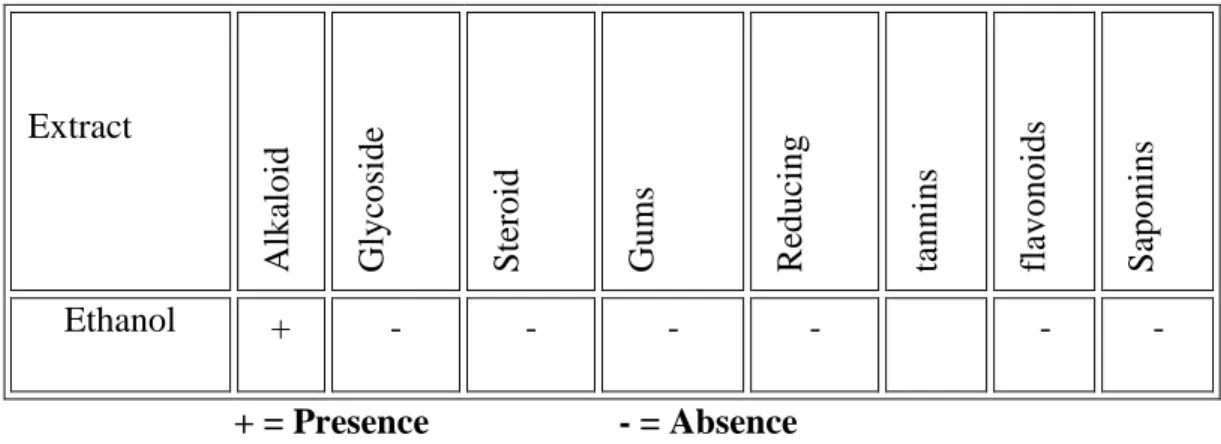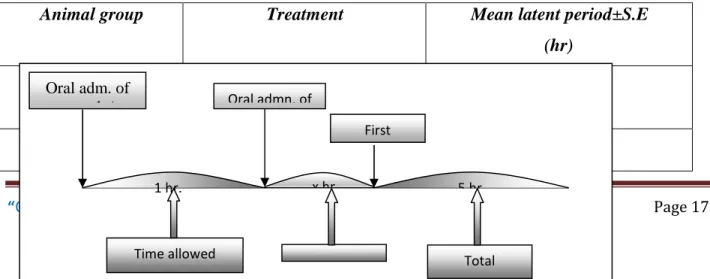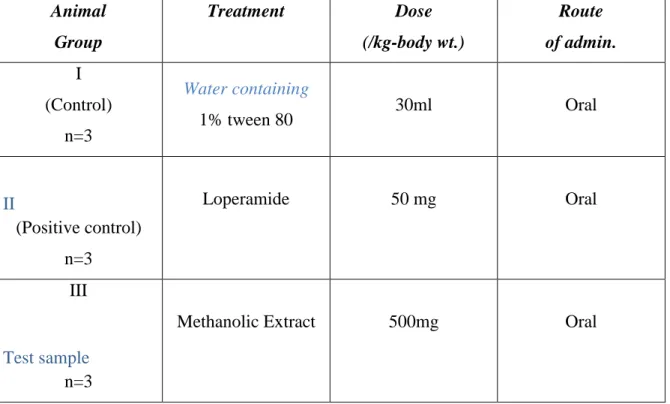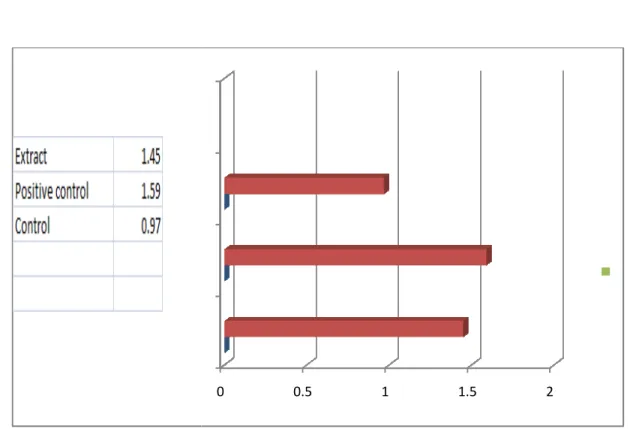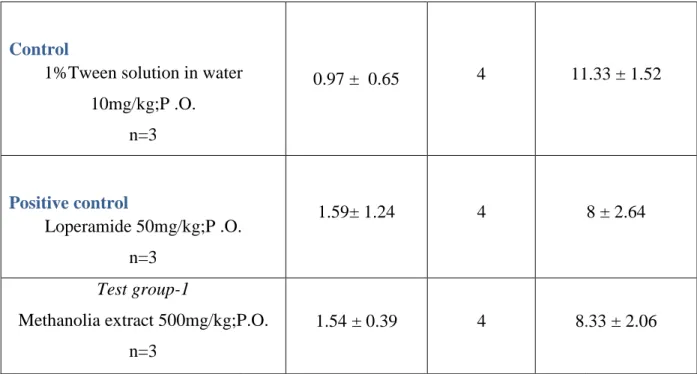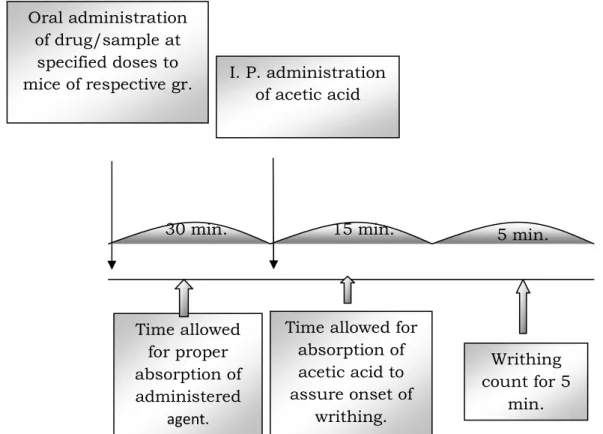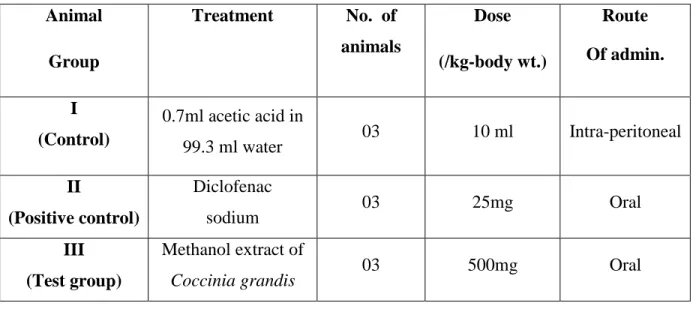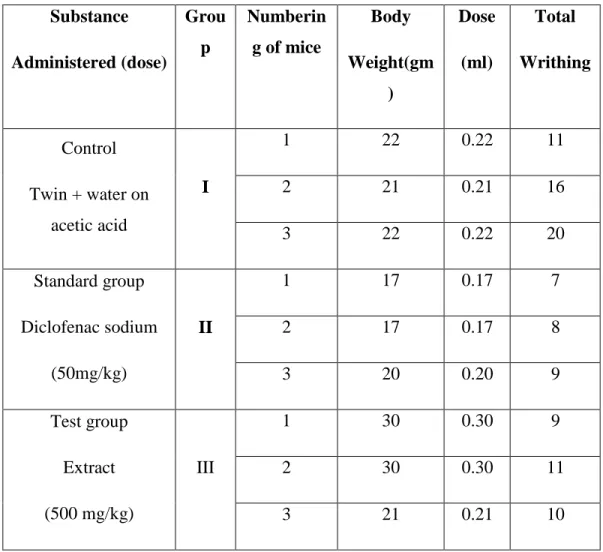Phytochemical & Pharmacological
Evaluations of heliotropium indicum.
Submitted By Supervised By
Shamim Ahmed
KH Ahammad Uz ZamanID# 113-29-330 Sr. Lecturer
DISSERTATION
Submitted in partial fulfillment of the requirements for The Degree of Bachelor of Pharmacy (B.Pharm)
Department of Pharmacy Daffodil International University
Date of Submission
January 2016
“©Daffodil International University”
Page i
ISSERTATION ACCEPTANCE FORM DAFFODIL INTERNATIONAL UNIVERSITY
DEPARTMENT OF PHARMACY
Certificate
This is to certify that the results of the investigation that are embodied in this project are original and have not been submitted before in substance for any degree or diploma of this university. The entire present work submitted as a project work for the partial fulfillment of the degree of bachelor of pharmacy, is based on the result of author ( Shamim Ahmed,ID:113-29-330) own investigation.
KH Ahammad Uz Zaman
Sr. Lecturer, Department of Pharmacy Faculty of Allied Health Science Daffodil International University
“©Daffodil International University”
Page ii
ACKNOWLEDGEMENT
I have taken efforts in this project. The success and final outcome of this project required a lot of guidance and assistance from many people and I am extremely fortunate to have got this all along the completion of my project work. Whatever I have done is only due to such guidance and assistance and I would not forget to thank them.
At the very beginning, I would like to express my sincere gratitude to Almighty, who has given me the chance to complete my project report in a very comfortable manner.
I take this opportunity to express my profound gratitude and deep regards to my teacher &
guide KH Ahammad Uz Zaman, Sr. Lecturer, Department of Pharmacy, Daffodil International University for his exemplary guidance, monitoring and constant encouragement throughout the course of this thesis. The blessing, help and guidance given by him time to time shall carry me a long way in the journey of life on which I am about to embark.
I am thankful to and fortunate enough to get constant encouragement, support and guidance from all Teachers of Department of pharmacy and also thanks to my friend Md.
Shamim Ahamed who helped me in successfully completing my project work.
My thanks and appreciations also go to my colleague in developing the project and people who have willingly helped me out with their abilities.
Lastly, I thank, my parents, brother, sisters and friends for their constant encouragement without which this project would not be possible.
Date: January 01, 2016 The Author
“©Daffodil International University”
Page iii
DEDICATED TO
MY BELOVED PARENTS
“©Daffodil International University”
Page iv
Table of content
Chapter two Phytochemical Screening Page no 6-14
2.1 Introduction 6
2.2 Materials and methods 7
2.2.1 Collection 7
2.2.2 Preparation of crude extract 7-8
2.3 Chemical Group Tests 9
2.3.1 Reagents used for the different chemical group test 9 2.3.2 Tests procedure for identifying different chemical groups 10-11
2.5 Results & Discussions 14
2.6 Conclusion 14
“©Daffodil International University”
Page v
Chapter One Introduction Page No 1-5
1.1 Literature Review 1
1.1.1 Botanical feature 1
1.1.2 Plant Morphology 2
1.1.3 Traditional use 2
1.1.4 Chemical Constituents 2
1.1.5 Biology and Ecology 3
1.1.6 Impact 3
1.1.7 Plant preview 4
1.2. Aim of project work 5
Chapter Three Antidiarrheal Page No
3.1 Introduction 15
3.2 Antidiarrheal activity of Heliotropium indicum by castor oil induced diarrhea in mice
15
3.2.1 Principle 15
3.2.2 Mechanism of diarrheal action of castor oil 15
3.2.3 Materials and Method 16
3.2.3.1 Preparation of Sample 16
3.2.3.2 Methodology 16
3.2.3.3 Conclusion 20
Chapter Four Analgesic Page
No
4.1 Introduction 21
4.2 Pharmacological investigation for analgesic activity 21
4
4..33 Materials and method 22
4.3.1 Study of analgesic activity by acetic acid induced writhing method 22 4.3.2 Mechanism of pain induction in acetic acid induced writhing method 22
4.3.3 Experimental animal 24
4.3.4 Study design 24
4.3.4.1 Preparation of test sample 25
4.3.4.2 Methodology 25
4.4.44 Result and discussion 26
4.6 Conculation 28
Chapter Five Summary of finding 29-30
Chapter Six References 31-32
“©Daffodil International University”
Page vi
“©Daffodil International University” Page 1 CHAPTER - ONE
INTRODUCTION
Heliotropium indicum is a medicinal plant which posses important active principals that have special medicinal value and various parts of plants are traditionally use against a variety of diseases by the rural people. The plant is a annual herb with very small flowers, fruits, grows in tropical and warm areas of Bangladesh.
1.1 Literature Review 1.1.1Botanical feature:
Rank Scientific Name and Common Name
Kingdom Plantae – Plants
Subkingdom Tracheobionta – Vascular plants Superdivision Spermatophyta – Seed plants
Division Magnoliophyta – Flowering plants Class Magnoliopsida – Dicotyledons
Subclass Asteridae
Order Lamiales
Family Boraginaceae – Borage family
Genus Heliotropium L. – heliotrope
Species Heliotropium indicum L. – Indian heliotrope
“©Daffodil International University” Page 2 1.1.2 Plant Morphology:
Height: H. indicum is an erect, robust, coarse, succulent annual herb with branched stem and strong taproot. Usually the plant attains a height of 1 m, but sometimes it may grow as tall as 1.5 m.
Leaves: Leaves opposite or alternate, 3-15 cm long, 2-10 cm wide, ovate to oblong-ovate, with dense, long white hairs on both surfaces. The lower surface of the leaf is pubescent, acute or acuminate.
Root: The root portion 9-16 cm long.
Flowers: bisexual with five sepals, lanceolate, 2-3 mm long; Corolla lilac to occasionally white.
Fruits: angular with an apical beak, 2-3 mm long, glabrous with two lobes which spread apart and separate to give two nutlets at maturity.
Location: Asia, Africa, North Aamerica, Central Aamerica and Caribbian, Soth America, Europe (UK, Australia, Australian Northern Territory, -Queensland).
1.1.3Traditional use:
The traditional medicinal uses such as relieving abdominal pain, hypertension and impotence and sexual weakness were explained by the receptor activity of H. indicum . The essential oil from the aerial parts of the herb showed significant antituberculosis activity. Significant antimicrobial, antioxidant, cytotoxic, thrombolytic and membrane stabilizing activity of this herb were reported.
1.1.4Chemical Constituents
Aerial parts contain pyrrolizidine alkaloids, indicine ,echinitine, supinine, heleurine, heliotrine, lasiocarpine, its N-oxide, acetyl indicine, indicinine and anti-tumour alkaloid, indicine-N-oxide.
The plant also contains rapanone and lupeol and an ester of retronecine. Roots contain high amount of estradiol (Ghani, 2003; Rastogi & Mehrotra, 1993).
“©Daffodil International University” Page 3 1.1.5Biology and Ecology:
H. indicum is a coarse annual weed and one of the most commonly encountered species of the genus. The plant reproduces by seeds which are produced on the long, curled, one-sided spikes.
The seeds are produced for a long period and the flowers continue to produce new seeds while mature seeds are still falling (Tadulingham and Venkatanarayana, 1932). Its ability to grow in periodically wet or partiailly flooded situations enables it to establish in crops under conditions where weeds sensitive to excess water could not endure.
1.1.6Impact:
H. indicum is common in tropical countries, being a major weed of sugarcane in Indonesia and the Philippines (Holm et al., 1991) and of maize in Myanmar, Thailand, Vietnam and the Philippines (Waterhouse, 1993). It is also reported as a weed of rice in Bangladesh, Indonesia, India, Laos, Malaysia, Philippines, Thailand and Vietnam (Moody, 1989). In Venezuela, it is a common weed of sugarcane in Aragua and Portuguese states (Rincones, 1975, 1989), of sesame (Sesamum indicum) (Prieto and Leon, 1975) and of several other crops (Anzola, 1989). It is a common weed of crops in several other countries including Taiwan.In addition to being a weed in different crops in various tropical and subtropical regions of the world, H. indicum, like several other members of Boraginaceae, possesses pyrrolizidine alkaloids which have a hepatotoxic effect in cattle (Birecka et al., 1980; Morris and Zambrano, 1991).
“©Daffodil International University” Page 4 1.1.7Plant preview:
Fig1.1: Heliotropium indicum ( whole plant)
Fig1.2: Fruits and Flowers
“©Daffodil International University” Page 5 1.2. Aim of project work:
Since Bangladesh is a country of low economic growth .So scientific exploration and standardization of potential crude drugs is an urgent need to revolutionize our drug sector.
Plant secondary metabolites have been used for mankind as remedies since the beginning of civilization. Now a day they still play an important role in health care for about 80% of the world' population.
Divers bioactive metabolites like steroids, terpenoids, flavonoids, alkaloids, glycosides, etc.in plants have formed the therapeutic basis of herbal medication. Thus emphasis is given on the biological screening of medicinal plants for further exploration of their active constituents.
Besides, Bangladesh imports a large quantity of pharmaceutical raw materials including
medicinal plants and semi processed plant products to produce drugs and medicines. This huge foreign exchange can be saved if the indigenous medicinal plants or their semi-processed
products are utilized by the manufacturers to satisfy their needs. Since there is a vast resource of different species of this genus (Cleome) in Bangladesh.
The present project work was designed to investigate the scientific basis of the traditional use of this plant for its:
1.Antidiarrheal 2. Analgesic activity.
3.Phytochemical screening
“©Daffodil International University” Page 6 Chapter - TWO
PHYTOCHEMICAL SCREENING
2.1Introduction
The subject of phytochemistry or plant chemistry has developed in recent years as a distinct discipline, somewhere in between natural product organic chemistry and plant biochemistry and is closely related to both. It is concerned with the enormous variety of organic substances that are elaborated and accumulated by plant and deals with the chemical structures of these substances, their biosynthesis, turnover and metabolism, their natural distribution and their biological function.
In all these operations, methods are needed for separation, purification and identification of many different constituents present in plants. Thus advances in our understanding of phytochemistry are directly related to the successful exploitation of known techniques, and the continuing development of new techniques to solve outstanding problems as they appear. As a result of modern extraction, and isolation techniques and pharmacological testing procedures, new plant drugs usually find their way into medicine as purified substances rather than in the form of galenical preparations.
The precise mode of extraction naturally depends on the texture and water content of the plant material being extracted and on the type of substance that is being isolated. Generally, two type of procedure are used for obtaining organic constituents-
1. Cold extraction and 2. Hot extraction
The classical chemical procedure for obtaining organic constituents from dried plant tissue (heartwood, dried seeds, root, leaf) is to continuously extract powdered material in a sox let
“©Daffodil International University” Page 7 apparatus with a range of solvents, starting in turn with petroleum ether and chloroform (to separate lipids and terpenoids) and then using alcohol and ethyl acetate (for more polar compounds).
The extract obtained is then carried out in a rotary evaporator which will concentrate bulky solution down to small volumes. In most cases, mixtures of substances will be present in the extract and these are subjected to chromatographic fraction (J.B Harbone, 1984). If a single substance is present, the crystals can be purified by recrystalization. As standard precaution against loss of material, concentrated extracts should be stored in the refrigerator and a trace of toluene added to prevent fungal growth.
The separation and purification of plant constituents is mainly carried out using Thin Layer Chromatography (TLC) and column chromatography. The choice of techniques depends largely on the solubility properties and volatilities of the compounds to be separated.
2.2 Materials and methods:
2.2.1 Collection
For this present investigation the Heliotropium indicum was collected from the campus of Khulna University, Khulna.
2.2.2 Preparation of crude extract Drying and grinding
The collected plant parts were separated from undesirable materials or plants or plant parts.
They were sun-dried for one week after cutting into small pieces. The plant parts were ground into a coarse powder with the help of a suitable grinder. The powder was stored in an airtight container and kept in a cool, dark and dry place until analysis commenced.
“©Daffodil International University” Page 8 Cold extraction (Methanol extraction)
About 400 gm of powered material was taken in a clean, flat bottomed glass container and soaked in 1300 ml of 80% methanol. The container with its contents was sealed and kept for a period of 7 days accompanying occasional shaking and stirring. The whole mixture then underwent a coarse filtration by a piece of clean, white cotton material. Then it was filtered through whatman filter paper (Bibby RE200, Sterilin Ltd., UK).
Extraction at a glance:
Plant collection
Drying
Milling
Powder of Heliotropium indicum
Macerated with methanol for 4 days
Heating in reflex condenser for 4 hours at 80oc
Filtration by vacuum
Crude methanol extract
“©Daffodil International University” Page 9 Evaporation of the solvent
The filtrate (methanol extract) obtained was evaporated under ceiling fan and in a water- bath until dried. It rendered a gummy concentrate of reddish black color. The gummy concentrate was designated as crude extract of methanol.
2.3 Chemical Group Tests
Testing of different chemical groups present in extract represent the preliminary phytochemical studies . The chemical group test, which are performed as follows (Trease et al., 1983). In each test 10% (w/v) solution of extract in methanol was taken unless otherwise mentioned in individual test.
2.3.1 Reagents used for the different chemical group test
The following reagents were used for the different chemical group test (Trease et al., 1983).
i) Mayer’s reagent:
1.36 gm mercuric iodide in 60 ml of water was mixed with a solution contains 5 gm of potassium iodide in 20 ml of water.
ii) Dragendroff’s Reagent:
1.7 gm basic bismuth nitrate and 20 gm tartaric acid ware dissolved in 80 ml water. This solution was mixed with a solution contains 16 gm potassium iodide and 40 ml water.
iii) Fehling’s solution A:
34.64 gm copper sulphate was dissolved in a mixture of 0.50 ml of sulfuric acid and sufficient water to produce 500 ml.
iv) Fehling’s solution B:
176 gm of sodium potassium tartarate and 77 gm of sodium hydroxide were dissolved in sufficient water to produce 500 ml. Equal volume of above solution were mixed at the time of use.
“©Daffodil International University” Page 10 v) Benedicts Reagent:
1.73 gm cupric sulphate, 1.73 gm sodium citrate and 10 gm anhydrous sodium carbonate were dissolved in water and the volume was made up to 100 ml with water.
vi) Molish Reagent:
2.5 gm of pure α-naphthol was dissolved in 25 ml of ethanol.
2.3.2 Tests procedure for identifying different chemical groups
The following tests were performed for identifying different chemical groups (Ghani, 1998).
Test for alkaloids Mayer’s test
2 ml solution of the extract and 0.2 ml of dilute hydrochloric acid were taken in a test tube.
Then 1 ml of Mayer’s reagent was added. Yellow color precipitate was formed and that was indicated as the presence of alkaloids.
Dragendroff’s test
2 ml solution of the extract and 0.2 ml of dilute hydrochloric acid were taken in a test tube.
Then 1 ml of Dragendroff’s reagent was added. Orange brown precipitate was formed and that was indicated as the presence of alkaloids.
Tests for Glycosides
A small amount of an alcoholic extract of the fresh or dried plant material was taken in 1ml of water. Then, a few drops of aqueous sodium hydroxide were added. A yellow color was considered as an indication for the presence of glycosides.
A small amount of an alcoholic extract of the plant material was taken in water and alcohol and boiled with Fehling’s solution. Brick-red precipitate was considered as an indication for the presence of glycosides.
“©Daffodil International University” Page 11 Another portion of the extract was dissolved in water and alcohol and boiled with few drops of dilute sulfuric acid, neutralized with sodium hydroxide solution and boiled with Fehling’s solution. Brick red precipitate was considered as an indication for the presence of glycosides.
Test for Steroids Sulphuric acid test
1 ml solution of chloroform extract was taken and then added1ml Sulphuric acid Red color indicates the presence of steroid.
Test for gums
5 ml solution of the extract was taken and then molish reagent and sulphuric acid were added.
Red violet ring produced at the junction of two liquids indica te the presence of gums and carbohydrate
Tests for reducing sugar Benedict’s Test
0.5 ml of aqueous extract of the plant material was taken in a test tube. 5ml of benedict’s solution was added to the test tube, boiled for 5 minutes and allowed to cool spontaneously.
A red color precipitate of cuprous oxide was formed in the presence of a reducing sugar.
Fehling’s Test (Standard Test)
2ml of an aqueous extract of the plant material was added 1ml of a mixture of equal volumes of Fehling’s solutions A and B. Boiled for few minutes. A red or brick red color precipitate was formed in the presence of a reducing sugar.
Alpha Naphthol Solution test
5 ml solution of extract added with 2 drops of 5% alpha- Naphthol solution (Freshly prepared) and added 1 ml of sulfuric acid on the sides of the test tube. Violet colored ring was formed at the junction of two liquids in the presence of reducing sugars.
“©Daffodil International University” Page 12 Tests for tannins
Ferric Chloride Test
5 ml solution of the extract was taken in a test tube. Then 1 ml of 5%Ferric chloride solution was added. Greenish black precipitate was formed and indicated the presence of tannins.
Test for Flavonoids
Added a few drops of concentrated hydrochloric acid to a small amount of an alcoholic extract of the plant material. Immediate development of a red color indicates the presence of Flavonoids Test for Saponins
1 ml solution of the extract was diluted with distilled water to 20 ml and shaken in a graduated cylinder for 15 minutes. One centimeter layer of foam indicates the presence of saponnins.
Table2.1: Different chemical group tests performed and the results are mentioned
Sample Test solution Observation Inference
Test for Alkaloids:
# 2 ml solution of the extract and 0.2ml of dilute hydrochloric acid
0.1 ml of Mayer’s reagent.
Yellowish buff colored precipitate was obtained.
Presence of alkaloid.
# 2 ml solution of the extract and 0.2 ml of dilute hydrochloric acid.
0.1 ml of Dragendroff’s reagent.
Orange brown precipitate was not found.
Absence of alkaloid.
Test For Glycosides:
#A small amount of an alcoholic extract was taken in 1ml of water.
A few drops of aqueous NaOH was added.
A yellow color was not found.
Absence of glycosides.
“©Daffodil International University” Page 13
# A small amount of an alcoholic extract was taken in water and alcohol.
Boiled with Fehling’s solution.
Brick-red precipitate was not found.
Absence of glycosides.
Test for Steroids:
# 10 mg extract dissolved in 1 ml chloroform.
1 ml sulfuric acid. No Chloroform layer acquired reddish brown color .
Absence of steroid.
Tests for Gums :
# 5 ml solution of extract.
Molish reagent and sulfuric acid.
Red –violet ring produced at the junction of two liq.
Absence of gums.
Tests for Flavonoids:
# 1 ml solution of ethanolic extract.
Few drops of conc. HCl was added to the extract
Immediate red color was not formed.
Absence of Flavonoids.
Tests for Saponins:
# 1 ml solution of the extract was diluted with distilled water to 20 ml.
Shaken in a graduated cylinder for 15 minutes.
No centimeter layer of foam.
Absence of saponins.
Tests for Reducing sugars:
# 5 ml solution of extract.
5 ml Fehling’s A and B solution boiled for 5 minutes on a boiling water bath.
Brick red colored precipitate was not obtained
Absence of reducing sugars
# 5 ml solution of extract. 5 ml Benedict’s reagent and boiled for 5 minutes on a boiling water bath
Brick red color is not precipitate.
Absence of reducing sugars Tests for Tannins:
# 5 ml solution of extract.
1 ml of 10% Lead acetate solution.
Yellow precipitate Was not obtained
Absence of tannins.
“©Daffodil International University” Page 14 2.5 Results & Discussions
Table 2.2: Results of different group tests are given bellow
Extract
Alkaloid Glycoside Steroid Gums Reducing sugars tannins flavonoids Saponins
Ethanol + - - - -
+ = Presence - = Absence
Phytochemical studies showed that alkaloids and tannins are present in the methanolic extract.
2.6 Conclusion
The experimental findings from the study showed that the methanolic extract has organic compounds which can show extensively pharmacologic activity.
“©Daffodil International University” Page 15 CHAPTER – THREE
ANTIDIARRHEAL TEST 3.1 Introduction:
Diarrhea is too frequent, often too passage of poorly formed stools. In pathological term, it occur due to passage of excess of water in faces. In the ileum and colon active Na+K+ATPase mediated salt absorption occur, water follows isoosmotically. In addition glucose facilitated Na+ absorption take place in the ileum. This mechanism remains intact even in severe diarrheas.
Diarrhea associated with characinoid (secreting 5-HT) and modularly carcinoma of thyroid (secreting calcitonon). It is mediated by cAMP. Excess of bile acids also causes diarrhea by activating adenyl cyclase (Tripathi , 2001).
3.2 Antidiarrheal activity of Heliotropium indicum by castor oil induced diarrhea in mice:
3.2.1 Principle:
Diarrhea was defined by the presence of stool or any fluid material that stained the absorbent paper placed beneath the cage. Time taken before the first defecation is the ‘Latent period’. The total count stool and latent period of test group are compared with positive control group. Anti- diarrheal agent increase latent period and decrease total stool count.
3.2.2 Mechanism of diarrheal action of castor oil:
Upon oral administration, castor oil mixes with bile and pancreatic enzymes and liberates ricinoleic acid from the triglyceride. A small amount of ricinoleic acid is absorbed from the gastrointestinal tract and metabolized like any other fatty acid but most remains in the intestine where it produces its anti-absorptive or secretory effect. The ricinoleic acid thus liberated readily forms ricinoleate salts with sodium and potassium in the lumen of the intestine. The ricinoleate salt formed as such behaves like a soap or surfactant within the gut and at the mucosal surface.
The precise with serotonin (5-HT) have been termed as “diarrhoeangenic hormones mechanism
“©Daffodil International University” Page 16
“of how ricinoleate salts induce diarrhoea is yet to be unknown. But most agreed view is that it stimulates the intestinal epithelial cell’s adenyl cyclase, release prostaglandins and specially prostaglandins of the E series along”.
3.2.3 Materials and Method 3.2.3.1 Preparation of Sample
To prepare suspension of the test samples at the doses of 500 & 250 mg/kg per body weight, 250 & 125 mg of samples were measured respectively. The extract was triturated in unidirectional manner by the addition of small amount of tween 80. After proper mixing of extract and tween 80 the distilled water was slowly added. The final volume of the suspension was made 5.0ml.
3.2.3.2 Methodology:
The mice were all screened initially by giving 0.5 ml of castor oil and only those showing diarrhea were selected for the final experiment. The test animals were randomly chosen and divided into three groups having five mice in each. Of the experimental groups, group-I or the control received only distilled water containing 1% Tween-80.
Group-II or the positive control received standard antimotility drug, loperamide at a dose of 50mg/kg-body weight as oral suspension. The test group was treated with suspension of seeds extract of Heliotropium indicum at the oral dose of 250mg/kg-body weight and 500mg/kg-body weight.
The mice were fed with the samples 1 hour prior to the oral administration of castor oil at a dose of 0.5ml per mouse. Individual animals of each group were placed in separate cages having adsorbent paper beneath and examined for the presence of diarrhea every hour in five hours study after the castor oil administration.
Number of stools or any fluid material that stained the adsorbent paper were counted at each successive hour during the 5-hour period and were noted for each mouse.
“©Daffodil International University” Page 17 The latent period of each mouse were also counted. At the beginning of each hour new papers were placed for the old ones.
Table 3.1: Experimental profile to observe the effect of Leaf of heletropium indicum on castor oil induced diarrhoea in mice.
Animal Group
Treatment Dose
(/kg-body wt.)
Route of admin.
I (Control)
n=3
Water containing
1% tween 80 30ml Oral
II
(Positive control) n=3
Loperamide 50 mg Oral
III
Test sample n=3
Methanolic Extract 500mg Oral
n=no. of mice
Table 3.2: Effect of Leaf of Heliotropium indicum on the latent period of castor oil induced Diarrheal episode in mice: Mean latent period
Animal group Treatment Mean latent period±S.E
(hr) I
(Control) n=3
1%tween-80 solution in water Orally
0.97 ± 0.65
II
(Positive control)
Loperamide(50mg/kg) Orally
1.59± 1.24 Oral adm. of
sample/
1 hr.
Time allowed To assure
5 hr.
Oral admn. of
Latent Total
First
x hr.
“©Daffodil International University n=3
III (Test group-1)
n=3
Ethanol extract(500mg/kg)
n=no. of mice.
Figure 3.2: Effect of crude extract of
mice. Each bar represents mean latent period.
Table 3.3: Effect of crude extract on mean of stool of diarrheal episode in mice.
Animal group/Treatment
Daffodil International University”
Ethanol extract(500mg/kg) Orally
1.45 ± 0.39
Figure 3.2: Effect of crude extract of Heliotropium indicum on castor oil induced diarrhea of mice. Each bar represents mean latent period.
Table 3.3: Effect of crude extract on mean of stool of diarrheal episode in mice.
Mean latent period ±S.E.M
Peroid of study(hr)
Mean of stools±S.E.M
0 0.5 1 1.5
Page 18 1.45 ± 0.39
on castor oil induced diarrhea of
Table 3.3: Effect of crude extract on mean of stool of diarrheal episode in mice.
Mean of stools±S.E.M
2
“©Daffodil International University Control
1%Tween solution in water 10mg/kg;P .O.
n=3
Positive control
Loperamide 50mg/kg;P .O.
n=3 Test group-1
Methanolia extract 500mg/kg;P.O.
n=3 n=no of animal
Figure 3.3: Effect of crude extract on time for onset of diarrheal episode. Each bar represents mean latent period ± SEM.
3.2.5. Result and Discussion:
0 Control Positive control Extract
Daffodil International University”
0.97 ± 0.65 4 11.33 ± 1.52
1.59± 1.24 4 8 ± 2.64
Methanolia extract 500mg/kg;P.O. 1.54 ± 0.39 4 8.33
Figure 3.3: Effect of crude extract on time for onset of diarrheal episode. Each bar represents mean latent period ± SEM.
2 4 6 8 10 12
Page 19 11.33 ± 1.52
8 ± 2.64
8.33 ± 2.06
Figure 3.3: Effect of crude extract on time for onset of diarrheal episode. Each bar
“©Daffodil International University” Page 20 The table 3.2 showed at the doses of 500 mg/kg-body weight, the isolated compound, Heliotropium indicum compared to the control group, offered 1.54 of the mean latent period for diarrheal episode to ensue and the result was significant inhibitory effect of diarrhea. And the mean numbers of stool during 4 hours of study were 4.66.
Heliotropium indicum showed a marked anti-diarrheal activity in castor oil induced test in mice at the doses of 500mg/kg-body weight as compared to the standard anti-diarrheal agent loperamide. Coccinia grandis caused an increase in latent period i.e. delayed the onset of diarrheal episode and decreased the frequency of defecation.
The decreased frequency of defecation and increase mean latent period of test group than control group and comp region with positive control group, we claimed that Heliotropium indicum possess anti-diarrheal activity.
3.2.3.3Conclusion: From the above observation it can be suggested that the methanolic extract of Coccinia grandis has anti-diarrheal activity. Moreover it is a preliminary investigation.
Further study should be done for more scientific evidence.
“©Daffodil International University” Page 21 CHAPTER – FOUR
ANALGESIC TEST 4.1. Introduction
The acetic acid induced writhing method is an analgesic behavioral observation assessment method that demonstrates a noxious stimulation in mice. The test consists of injecting the 0.7%
acetic acid solution intra-peritoneal and then observing the animal for specific contraction of body referred as ‘writhing’. A comparison of writhing was made between positive control (Diclofenac-Na), control and test sample given orally 30 minutes prior to acetic acid injection. If the sample possesses analgesic activity, the animal that received the sample will give lower number of writhing than the control, i.e. the sample having analgesic activity will inhibit writhing.
4.2. Pharmacological investigation for analgesic activity
An analgesic selectively relieves pain by acting in the CNS or on peripheral pain mechanisms, without significantly altering consciousness. They are used when the noxious stimulus (evoking the pain) cannot be removed or as adjutants to more etiological approach to pain. Analgesics are divided into two groups, viz.
Opoid/narcotic/morphine like analgesics:
These are strong analgesics. They depress CNS.
Non-opoid/non-narcotic/aspirin like/antipyretic or anti-inflammatory analgesics:
These are weaker analgesics. They do not depress CNS, do not produce physical dependence and have no abuse liability. They act primarily on peripheral pain mechanisms, also in CNS to arise pain threshold.
“©Daffodil International University” Page 22 There are several methods to assess the analgesic activity at different steps of pharmacological investigation. The methods are
Acetic acid induced writhing method Radiant heat method
The method, which we were used to assess the analgesic activity at different steps of pharmacological investigation, was “Acetic acid induced writhing method”.
4
4..33.. MMaatteerriiaallss anandd MMeetthhoodd
4.3.1 Study of analgesic activity by acetic acid induced writhing method
The acetic acid induced writhing method is an analgesic behavioral observation assessment method that demonstrates a noxious stimulation in mice. The test consists of injecting the 0.7%
acetic acid solution intra-peritoneal and then observing the animal for specific contraction of body referred as ‘writhing’. A comparison of writhing was made between positive control (Diclofenac sodium), control and test sample. Control, positive control (Diclofenac sodium) and test sample was given orally. Positive control and test sample was given orally 30 minutes prior to acetic acid injection. If the sample possesses analgesic activity, the animal that received the sample will give lower number of writhing than the control, i.e. the sample having analgesic activity will inhibit writhing.
Diclofenac sodium is used as reference standard drug. It has analgesic, anti- inflammatory and antipyretic actions. It is one of the important members of non-steroidal anti-inflammatory drugs.
It acts by inhibiting cyclooxygenase.
4.3.2. Mechanism of pain induction in acetic acid induced writhing method
Acetic acid is a pain stimulus. Intra-peritoneal administration of acetic acid (0.7%) causes localized inflammation. Such pain stimulus causes the release of free arachidonic acid from tissue phospholipid by the action of phospholipase A2 and other acyl hydrolyses.
“©Daffodil International University” Page 23 There are three major pathways in the synthesis of the eicosanoids from arachidonic acid. All the eicosanoids with ring structures that is the prostaglandins, thromboxanes and prostacyclines are synthesized via the cyclooxygenase pathway. The leucotrienes, HETE (hydroxy eicosatetraenoic acids) and HPETE (hydroperoxy eicosatetraenoic acids) are hydroxylated derivatives of straight- chain fatty acids and are synthesized via the lipooxygenase pathway.
The released prostaglandin’s, mainly prostacyclin (PGI2) and prostaglandin-E have been reported to be responsible for pain sensation by exciting the Aδ-fibres. Activity in the Aδ-fibres causes a sensation of sharp well localized pain.
Diclofenac sodium was used as the positive control in this method acts by inhibition of prostaglandin synthesis. Any agent that lowers the number of writhing will demonstrate analgesia by inhibition of prostaglandin synthesis, a peripheral mechanism of pain inhibition.
Figure 4.1: Schematic representation of acetic acid induced writhing of mice for investigation of analgesic activity.
Oral administration of drug/sample at
specified doses to mice of respective gr.
Time allowed for proper absorption of administered
agent.
30 min.
I. P. administration of acetic acid
Time allowed for absorption of acetic acid to assure onset of
writhing.
Writhing count for 5
min.
15 min. 5 min.
“©Daffodil International University” Page 24 4.3.3. Experimental animal
Young Swiss-albino mice aged 4-5 weeks, average weight 17-30 gm were used for the experiment. The mice were purchased from the animal Research Branch of the International Centre for Diarrhoeal Disease and Research, Bangladesh (ICDDR, B). They were kept in standard environmental condition for one week for adaptation after their purchase and fed ICDDR, B formulated rodent food.
4.3.4. Study design
Experimental animals were randomly selected and divided into three groups denoted as group-I, group-II, group-III consisting of 5 mice in each group. Each group received a particular treatment i.e. control, positive control and the two doses of the extract. Each mouse was weighed properly and the doses of the test samples and control materials were adjusted accordingly.
Table 4.1 Experiment profile to assess the effect of crude extract on acetic acid induced writhing of mice
Animal Group
Treatment No. of animals
Dose (/kg-body wt.)
Route Of admin.
I (Control)
0.7ml acetic acid in
99.3 ml water 03 10 ml Intra-peritoneal
II
(Positive control)
Diclofenac
sodium 03 25mg Oral
III (Test group)
Methanol extract of
Coccinia grandis 03 500mg Oral
“©Daffodil International University” Page 25 4.3.4.1. Preparation of test sample
To prepare suspension of the test samples at the doses of 500 mg/kg per body weight, 125 mg of samples were measured respectively. The extract was triturated in unidirectional manner by the addition of small amount of water to make a volume about 1.25 ml. For proper mixing of extract small amount of tween was added to stabilize the suspension.
For the preparation of diclofenac sodium at the dose of 25 mg/kg-body weights, 6.25 mg of diclofenac sodium was taken and a suspension of 2.5 ml was made.
4.3.4.2 Methodology
Test samples, control and diclofenac sodium were given orally by means of a feeding needle. A thirty minutes interval was given to ensure proper absorption of the administered substances.
Then the writhing inducing chemical, acetic acid solution (0.7%) was administered intraperitoneally to each of the animals of a group.
After an interval of 15 minutes, which was given for absorption of acetic acid, number of squirms (writhing) was counted for 5 minutes.
Figure 4.2: Swiss albino mouse Figure 4.3. Acetic acid induced writhing of mouse.
“©Daffodil International University” Page 26 4.4.44.. RREESSUULLTT AANNDD DDIISSCCUUSSSSIIOONN
Tabulation of writhing: Each mouse of all groups was observed carefully to count the number of writhing that they had made in 5 minutes.
Table 4.2: Statistical evaluation of the results 1 Substance
Administered (dose)
Grou p
Numberin g of mice
Body Weight(gm
)
Dose (ml)
Total Writhing
Control Twin + water on
acetic acid
I
1 22 0.22 11
2 21 0.21 16
3 22 0.22 20
Standard group Diclofenac sodium
(50mg/kg)
II
1 17 0.17 7
2 17 0.17 8
3 20 0.20 9
Test group Extract (500 mg/kg)
III
1 30 0.30 9
2 30 0.30 11
3 21 0.21 10
“©Daffodil International University” Page 27 Table 4.3: Statistical evaluation of the results 2
Animal group
Total
Writhing Mean % writhing
Standard deviation(SD)
Standard error
(SE)
% Protection
Control n=03
47 15.66 100 4.5 2.25
Diclofenac sodium
n=03
24 8 51 1 0.5 49
Extract (500 mg/kg)
n=03
30 10 64 1 0.5 36
n = Number of animals.
4.5 Result of statistical analysis
% Protection: The methanol extract of aerial parts of Heliotropium indicum produced 36%
protection or writhing inhibition in mice at orally doses of 500 mg/kg body weights of mice respectively.
“©Daffodil International University Figure 4.4:
4.6 Conclusion
From the above observation it can be suggested that th
indicum possess analgesic activity. However further researches are necessary to find out the analgesic activity of the active principles.
Daffodil International University”
Figure 4.4: % protection Vs Treatment curve
From the above observation it can be suggested that the methanolic extract of
analgesic activity. However further researches are necessary to find out the analgesic activity of the active principles.
0 10 20 30 40
1 2 3
Page 28 e methanolic extract of Heliotropium analgesic activity. However further researches are necessary to find out the
50 60
“©Daffodil International University” Page 29 CHAPTER FIVE
SUMMARY OF FINDINGS
The project work presented here deals with different studies on Heliotropium indicum.The investigations were carried on Phyto-chemistry and pharmacology.
The objective has been to explore and evaluate the analgesic, antimicrobial and activities to provide a suitable lead, which may be utilized in future to peruse a new line of investigation, based on the combined approach of both exploitation and exploration.
The investigational work performed and represented in this thesis has been divided into two major parts.
1) Phyto-chemical studies 2) Pharmacological studies
The authenticity of the plant specimen has been confirmed by Bangladesh National Herbarium, Mirpur, Dhaka, Bangladesh.
The dried leaves of Heliotropium indicum were powdered and extracted exhaustively by using continuous extraction process with organic solvent e.g. methanol. The solvent was distilled off and the extract was concentrated.
To get preliminary idea about the active constituents present in different extracts different chemical tests were performed and showed the presence of alkaloids and tannin.
Based on ancient practices, folklore use and pharmacological interests of Heliotropium indicum the present study was done to evaluate the analgesic and antidiarrheal activities in the experimental mice (average body weights 20-25 gm) and rats and thereby to substantiate the claim about the plant to be used in folklore medicine.
“©Daffodil International University” Page 30 From the study of analgesic activity it was found that methanolic extract of Heliotropium indicum at a dose 500 mg/kg exhibited highly significant inhibition of writhing reflex by 23 % while the standard drug diclofenac- Na inhibition was found to be 49% at the dose of 25 mg/kg body weight.
The extract produced a significant increase in the latent period at the dose of 500mg/kg in which the latent period was 1.54 hr. The result was Comparable with the standard drug loperamide in which the value was 1.59 hr.
Thus a thorough study on both aspects (phyto-chemical and pharmacological) has been made and represented in this thesis based on the combined approach of both exploitation and exploration which may lead to a new line of treatment by folklore herbal remedies.
“©Daffodil International University” Page 31 CHAPTER SIX
REFERENCES
1. Cookies onInvasive Species Compendium http://www.cabi.org/isc/datasheet/26899 2. Natural resoure conservation services united state of agricultural
http://plants.usda.gov/core/profile?symbol=HEIN.
3. Evans WC. 1989. Trease and Evan's Pharmacognosy. University Press, Cambridge.13th ed: pp. 546.
4. . (Ghani, 2003; Rastogi & Mehrotra, 1993).http://www.mpbd.info/plants/heliotropium- indicum.php
5. Maurice Navodita and Kumar Ashwani. Oviposition of Epilachna vigintioctopunctata Fabricius on a wild weed. Coccinia grandis Linnaeus (Cucurbitales: Cucurbitaceae.
Journal of Agricultural Extension and Rural Development. 2012; 4: 41-45.
6. Pekamwar et al./ journal of applied pharmaceutical science 3 (05);2013;114-119 .
7. Reddy Uma B. Cladistic analyses of a few members of Cucurbitaceae using rbc L nucleotide and amino acid sequences. International Journal of Bioinformatics Research, 2009; 1: 58-64.
8. Starr Forest., Starr Kim., and Lloyd Loope. Coccinia grandis Ivy gourd Cucurbitaceae.
United States Geological Survey. Biological Resources Division Haleakala Field Station, Maui, Hawai'I January, 2003
9. Starr Forest., Starr Kim., and Lloyd Loope. Coccinia grandis Ivy gourd Cucurbitaceae.
United States Geological Survey Biological Resources Division Haleakala Field Station, Maui, Hawai'I January, 2003
10. Tamilselvan N et al.,. Pharmacognosy of Coccinia grandis: a review. Asian Pacific Journal of Tropical Biomedicine. 2011; 1(1): S299-S302 .
11. Tripathi KD. 2001. Essentials of Medical Pharmacology, Updated Reprint 4th ed. Jaypee Brothers, Medical Publishers (p) LTD, New Delhi 110002. pp.432.
“©Daffodil International University” Page 32 12. Trease GE and Evans WC. (1983) Text book of pharmacognosy. Edition 12, Balliere
Tinad, London: 257.
